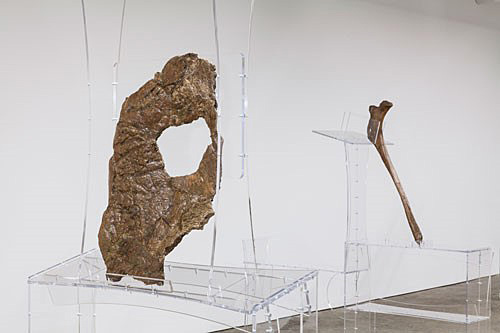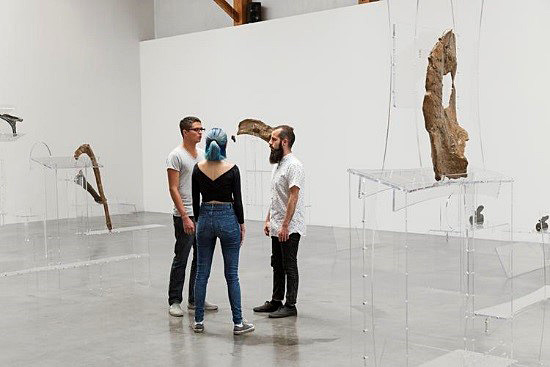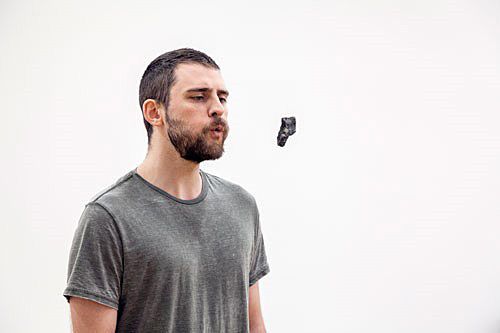August 10, 2016
Allora and Calzadilla’s tangible ecologies
Written by Louise Malcolm
Ecological problems, possibly due to their abstraction and scale, can be difficult to comprehend and to relate to in a way that is more than merely intellectual. They are so incredibly vast and simultaneously incredibly small in relation to human experience: a slight temperature change can melt ice caps while minute fluctuations in atmospheric chemicals can result in damage to the ozone layer. Intangible and indistinct, both fast and slow, it is difficult for humankind to grasp the impact of these changes. While eco-political art is usually directly related to activism or specific ecological problems, another – less direct but more sensory – artistic approach brings abstract concepts such as ecology, climate change or nature, closer to human experience.[1] Some of the most effective artists working in this sensory realm are the duo Jennifer Allora (b. 1974, Philadelphia) and Guillermo Calzadilla (b. 1971, Havana), whose artworks reignite our connection with the Earth and in doing so make ecology palpable.

This summer (2016) Allora and Calzadilla had their first major Canadian presentation, at the Art Gallery of Alberta. Alongside some of their most well-known pieces, such as the films Raptor’s Rapture (2012), Apotomē (2013) and 3 (2013), the duo, inspired by a research trip they had taken to Alberta in 2014, exhibited new artworks made in response to the Alberta regionsand, more generally, Western Canada’s prehistoric past.[2]

Their sculpture Intervals (2014), which formed a central part of the exhibition, displayed dinosaur bones from Alberta’s Royal Tyrrell Museum of Palaeontology on reconfigured transparent acrylic lecterns. The rough texture of the fossilised fragments of dinosaur bone, surfaces formed by millennia of earthly processes, contrasted with the ultra-modernity of the gallery space, juxtaposing prehistoric and modern timescales to give a fractured reading of time.

Intervals was accompanied by the vocal performance Lifespan (2014), during which the breath of three performers animated a suspended piece of Acasta River Gneiss rock from Canada’s North Western Territories. Accompanied by a composition by the American composer David Lang (b. 1957 Los Angeles), the three vocalists whistled and blew onto the rock, triggering it to move gently.

The exhibition title Allora & Calzadilla: Echo to Artifact summarised the artists’ central aim of facilitating an encounter between different temporalities, specifically between prehistoric and present time, by using sound to animate historical artefacts. The artists note: “The exhibition bears witness to incomplete presences and resonant remainders from the past. It finds in music a measure and a reckoning with these elusive forces and the abyss that lies between."[3] By creating encounters between multiple temporalities and by working in the space between Earth’s deep past and its present, the exhibition brings humankind’s short temporality on earth into focus and reveals the ecological dimension of Allora and Calzadilla’s work. Through transporting objects with prehistoric or archaeological timespans into the gallery – and, most importantly, by animating them with sounds and performances – Allora and Calzadilla bring abstract concepts into our familiar world. This life world – our Lebenswelt –forms our human experience. Lebenswelt is a term borrowed from phenomenology, the philosophical movement that stresses the importance of direct, unfiltered experience for human perception. According to phenomenologists, we do not experience things as a stack of separate characteristics but rather perceive them in their entirety. Human modes of perception presuppose a social, cultural and historical grounding, a common Lebenswelt that is the theatre of our human experience and condition. As Martin Heidegger explains:
What we ‘first’ hear is never noises or complexes of sounds, but the creaking waggon, the motor-cycle. We hear the column on the march, the north wind, the woodpecker tapping, the fire crackling […]. It requires a very artificial and complicated frame of mind to ‘hear’ a ‘pure noise’. The fact that motor-cycles and wagons are what we proximally hear is the phenomenal evidence that in every case Dasein, as being-in-the-world, already dwells alongside what is ready-to-hand within-the-world; it certainly does not dwell proximally alongside ‹sensations›; nor would it first have to give shape to the swirl of sensations to provide a springboard from which the subject leaps off and finally arrives at a ‘world’. Dasein, as essentially understanding, is proximally alongside what is understood.[4]
Here Heidegger proposes that to fully understand a ‘thing’ we must consider it in its entirety, including its perceivable and imperceptible characteristics, something that is only possible if an object exists in our Lebenswelt. Studying how Allora and Calzadilla’s creative strategies bring previously ungraspable prehistoric objects into the Lebenswelt is the key to unlocking the ecological dimension of their work. There are several primary ways they do this in the artworks presented in the Alberta exhibition, and in particular the artworks Intervals (2014) and Lifespan (2014).
Temporality. Both Intervals (2014) and Lifespan (2014) juxtapose different time periods. This technique allows them to transport an inaccessible concept, such as Earth time (previously too far off to grasp) into human time and into the realm of our experience and understanding. For Intervals (2014) Allora and Calzadilla achieved this by transferring the dinosaur bones from their museum drawers onto lecterns dispersed throughout the gallery space.
Physicality. This transfer transmutes the bones from specimens into objects in a formation that can be experienced from three dimensions, by people circling them as they simultaneously encircle people. The acrylic lecterns support the dinosaur bones at the height they would be within the original skeleton. Balanced on the lectern, the bone fragments take the place of a book or speech, a poetic transfer of agency onto the mute bones. They act as three dimensional texts that tell us about the Earth’s past, as Jennifer Allora said when interviewed by Lilly Wei of Studio International: “We might think of them as messengers from a former world, insisting upon a new way of reading, on a new dialogue among and across species and times.”[5] Allora and Calzadilla do not interpret prehistoric artefacts but rather facilitate an encounter with them via a phenomenological strategy of letting ‘things themselves’ guide our understanding. In bringing the bones into physical proximity with us, by allowing us to engage with them bodily, the artists bring them into our Lebenswelt. This approach reflects the French phenomenologist Maurice Merleau-Ponty’s instance that ‘things themselves’ are best mediated through the body as the root of our being, rather than the mind.
Sound. The German theorist Theodore Adorno’s Valerie Proust Museum (1981) was one of the first museological texts to note that museums offer just a learning of culture, rather than culture itself. In this famous text Adorno emphasised the lifeless qualities of the museum objects, stating that “the museum and mausoleum are connected by more than phonetic association”.[6] As a way of bringing their objects to life, and to further distinguish their viewing experience from the museum experience, Allora and Calzadilla use sound. Lifespan (2014) uses the performer’s breath to animate a Gneiss rock from Canada’s Acasta River.
The performance starts quietly, with the performers silently blowing air in long streams towards the suspended stone, evolves into a harmony of tonal whistling and sharp exhalations and culminates in high pitched whistles. At 4 billion years old, the Gneiss rock is the oldest known intact crustal fragment on Earth and, when displayed in a museum cabinet, is distant from any cultural experience we can relate to. Yet, with the force of breath, this ancient reminder of the Earth’s longevity is propelled into pendulaic movement and turned into a cultural experience in which we can participate, placing it within our conceptual grasp as something closely connected to our lives and worldly experience.
Memory. The Proustian concept of mémoire involontaire is a useful frame for understanding the significance of our Lebenswelt. The concept is described by the German theorist Walter Benjamin in his Collected Writings:
Concerning the mémoire involontaire: not only do its images appear without being called up; rather they are images we have never seen before we remember them. This is most clearly the case in those images in which – as in some dreams – we see ourselves. We stand in front of ourselves, the way we might have stood somewhere in a prehistoric past [Urvergangenheit], but never before our waking gaze.[7]
Within mémoire involontaire, images we have not seen – but which are familiar – appear, bringing us face-to-face with ourselves. Although clearly not mammalian bones, Intervals’ reptilian fragments arouse powerful recollections. They share a similar colour, shape and texture to human bones and, when confronted by them, one is compelled by their recognisable surface. They have a familiarity and attainable memory that places us in a new relationship with the Earth and with the long-extinct beasts that walked it long ago. This setting reminds us of our fragility and limited time on earth in a palpable, experiential way, rather than as an abstract concept. It is often held in contemporary thought that, in the modern era, our ways of knowing ourselves, others and the world have become rationalised and disembodied. By invoking mémoire involontaire via the transportation of ‘other worldly’ items into our Lebenswelt, Allora and Calzadilla reconnect and re-embody us, and explore what it means to be a human in the world. For Maurice Merleau-Ponty “all of [phenomenology’s] efforts are concentrated upon re-achieving a direct and primitive contact with the world, and endowing that contact with a philosophical status”,[8] and certainly the artworks discussed here ignite this ‘direct and primitive contact’.
The above discussion points have explored how this artist duo transform vast and abstract natural concepts into tangible experiences by bringing them into familiar contexts. By transforming ancient artefacts devoid of meaning for many viewers into lived perceptions, a phenomenon accessible to our mind and our Lebenswelt, the artists reconnect us to the Earth and its ecology. Although these art works are not yet a call to Eco-activism, they mark a first and necessary step towards it by sculpting a new interface between humans and the world. They bring the environment back into human experience. By using such an affective and experiential border we can transform abstract ecological problems into palpable experiences.
Such strategies thereby allow us to go beyond a purely intellectual access to the Earth and reach an instinctive and powerful understanding of it.
Louise Malcolm is a PhD candidate in Art History at the University of Zurich.
NOTES
[1] This approach has been discussed in Emily Eliza Scott “Feeling in the Dark: Ecology at the Edges of History.” American Art vol. 28, no. 3 (Fall 2014): 14-20, p 14
[2] These artworjs have also been shown at the Philadelphia Museum of Art and at the Fabric Workshop in 2014 and more recently in 2016 at kurimanzutto gallery in Mexico.
[3] Allora and Calzadilla quoted on the Philadelphia Museum of Art website: http://www.philamuseum.org/press/releases/2014/1031.html
[4] Martin Heidegger, Being and Time (1927), translated by J. Stambaugh, New York 1996, pp. 34, 207
[5] Allora and Caldazilla interviewed for Studio International, April 2015: http://www.studiointernational.com/index.php/allora-calzadilla-interview-intervals-film-conceptual-art
[6] Theodore Adorno, “Valery Proust Museum” (1981) in T. Adorno, Prisms, trans. S. and S. Weber, Cambridge, MA: MIT, pp 175-85, p. 175
[7] Walter Benjamin, Gesammelte Schriften (1972) in: Marie Bratu Hansen,‘ Benjamin’s Aura‘ 2008 p. 348.
[8] Maurice Merleau-Ponty, Phenomenology of Perception (1945), translated by Donald Landes, Abingdon 2002, p. vii









